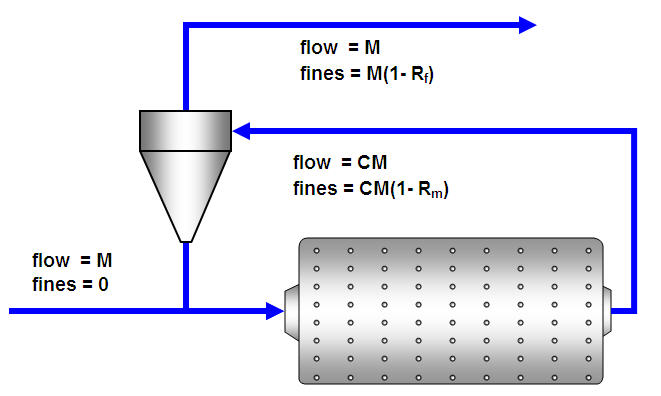138 posts
re Separator Efficiency Formula derivation
You should find all you need in this presentation:
http://www.asocem.org.pe/bivi/sa/cur/cemnet/classification_separation_session5.1.2.pdf
I didn't read it yet. However, it seems:
- this efficiency is related to the impact of the separator on the specific energy consumption
- this efficiency is not directly related to the other efficiencies you mentioned
- it is a result obtained from a very simple grinding model
- logarithms appear in the formula because the simple grinding model assumes a reduction of the residues by the mill according to a first-order process. This means that the residue at mill output and input (Rout and Rin) and the energy supplied in the mill (E) are related by this kind of formula: Rout = Rin exp(-E/Z) , where Z is a measure of the "hardness" of the material. (see page 1, 3th slide).
Although I did not read the details, I think it is rather easy to derive the formula.
The good idea is to compare the energetic benefit with a real separator to the benefit with an ideal separator. An ideal separator has a sharp cut and not bypass. The comparison is apparently easy because the closed circuit wouldn't need to be actually modelised
and solved.
However, I guess the weakness of the formula might be that the circulation factor C could be different for the perfect and the real separator. The difference could be quite high for example if the real separator had a bypass of 40%. Or could it be that considering
constant residue at the output makes that effect negligible? That could be a funny exercice. It would imply a modeling of the closed circuit and a solution of the model. Maybe the outcome remains the simple formula you asked for a derivation. That would be
fun, isn't it? But I have my doubts.
Let me add finally that this is not the whole story.
The qualities of cement obtained from a "real separator" and a "closer to ideal" separator are not the same. This might imply changing the operating set point, and this might also have some impact on the "energetic efficiency" as defined by FLS.
Know the answer to this question? Join the community and register for a free guest account to post a reply.
20 posts
138 posts
re Separator Efficiency Formula derivation
The efficiency defined according to this formula:
is easily understood from the following picture:
Dividing the amount of fines in the finish product by the amount of fines in the separator feed leads to this efficiency. The 1/C factor simply reflects for the fact that only a fraction 1/C of the circulating mass ends up in the finish product.
The "100" terms in the original formula are related to the percent units used which I do not like.
